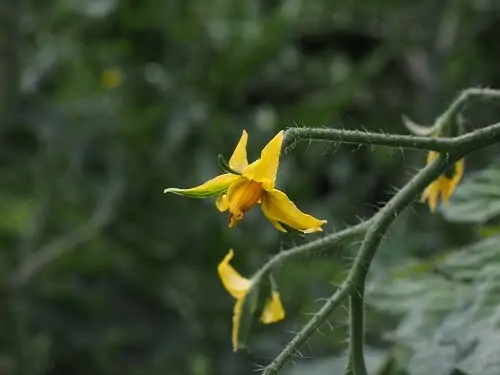Extreme cold or hot weather, lack of spacing, insufficient pollination, poor fertilization, and high humidity are the possible reasons for no tomato fruit set.
Tomato fruit setting problems mainly depend on Mother Nature. Even if you don’t notice any caring mistakes or serious plant health issues on tomatoes, this problem can occur only for temperature fluctuation.
So, you can’t control Mother Nature, but you can take some quick steps to reduce or fix the problem. Continue reading to learn more about tomato fruit setting problems and possible solutions.

1. Blossom drop or temperature fluctuation
Tomato blossom drops can happen in extreme hot and cold weather conditions. Both day and nighttime temperatures during the growing season can influence the blossom drop problem.
Blossom drop happens when the night temperature gets below 55° F or above 75° F. On the other hand, it may also occur when the daytime temperature gets below 70° F or rises above 90° F.
Temperature fluctuation is the main reason for the blossom drop. Besides, lack of pollination, imbalance of nitrogen supply, lack of water, humidity fluctuation, and plant stress from damage or diseases are other possible reasons for blossom drop.
Solution:
For hot weather conditions, use a temporary shade cloth to reduce the extreme heat of the midday and afternoon sun. It can protect tomato plants from the extra heat of the continuous heat days.
For cold weather conditions, use black or red plastic mulch to hold the heat from the sun to keep the soil warm at night.
Besides, regular watering and proper nutrient supply also help to reduce the blossom drop problem.
2. High humidity
Humidity slows down the process of pollination. Tomato flowers are self-pollinated, and typically the process can happen by wind, human movement, or other natural pollinators like bees, birds, and other insects.
But the high humidity makes the pollen of the flowers too wet to reach them up to the stigma to make successful pollination.
Solution:
If you live in an area with high humidity, you can simply tap on the flowers or flower stem to make manual pollination. Besides you can also use a soft paintbrush to transfer the pollen from one flower to another.
3. Improper tomato spacing and poor air circulation
Proper spacing between plants is very important to make good pollination. It ensures good air circulation among plants and helps pollination.
Short spaces between plants produce less fruit set and are also susceptible to some fungal diseases.
Solution:
Make sure at least a 2-3 feet distance between plants based on the tomato varieties.
4. Too many blossoms
Excessive blooming on tomatoes creates combat for nutrition. As a result, the tomato plants will abort some flowers automatically following the preservation method.
Solution:
Tomato plants will solve this problem automatically when they start producing fruits. Make sure your soil gets balanced nutrients during setting fruits.
5. Overfertilization or wrong way of fertilization
Overfertilization or lack of nutrient supply both may cause poor fruit set or poor flowering of tomatoes. Typically, tomatoes need three major fertilizers, N-P-K (nitrogen, phosphorus, and potassium) supply in different stages of plant growth.
Potassium and phosphorus help to set flowers and produce healthy fruit sets. So, phosphorus and potassium deficiency may cause poor flowering and fruit set during the growing season.
Solution:
Do the soil test first and apply fertilizer as the test result suggest. Typically, the 10-10-10 ratio of fertilizer is common for tomato plants.
But, at the beginning stage, you should apply enough nitrogen to develop tomato foliage and plant stems.
When the first flower appears at the second stages of plant growth, reduce the amount of nitrogen and increase the amount of phosphorus and potassium to produce a healthy fruit set.
Usually, after transplanting, tomato plants need 40-100 to bloom and set fruits based on different varieties. If you notice that your tomato plants are over foliage but have no bloom, do a gentle pruning to let the tomatoes begin flowering.
6. Water stress
Too little water or too much water both cause poor fruit development. To get a better fruit set, you need to moisten the soil evenly.
Solution:
Check the soil moisture first every time before applying water to the tomatoes.
Tomato plants need 1-3 gallons of water per week, depending on the weather condition. For dry weather conditions, you need to supply more water than average.
Besides, applying compost fertilizer and organic mulching around the base of the plants helps to hold the soil moisture for a longer period.
7. Lack of sunlight
Insufficient sunlight may cause poor fruit sets of tomatoes and leggy growth. Usually, tomato plants need 6-8 hours of direct sunlight to produce healthy fruit. Tomato plants convert sunlight into energy to produce fruits.
Solutions:
Make sure your planting area gets enough sunlight before transplant tomato plants. If you plant tomatoes in a container, move them to a suitable place where sunlight is available.
8. Poor pollination
Poor pollination may occur in extremely hot, dry, cold, or humid weather conditions. Besides little space between plants, windy weather and the absence of natural pollinators can cause poor pollination.
Solutions:
You can’t control Mother Nature, so be patient to let the weather get a fix by itself. You can also pollinate the tomatoes manually by hand.
